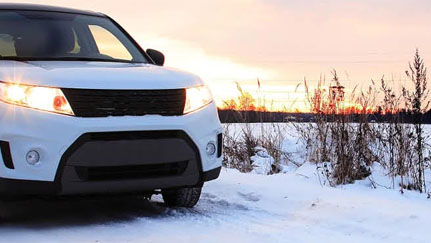
Winter brings all sorts of driving headaches: snow, freezing rain and slush, which all make the roads more hazardous.
People who grew up in cold-weather climates with winter storm warnings are most likely well-versed in how to drive in these conditions and have their cars stocked with emergency essentials.
But if you are going on a holiday, traveling to your wintry vacation home or living in a new state that may get walloped with a winter storm, then we recommend you review these eight simple steps to better handle the hassle of winter driving.
- Buckle up. Basic car safety encourages the use of seat belts and car seats at all times. They’re one of your best defenses in a crash. And they’re required by law in most states.
- Slow down. Use extra caution in areas that ice up quickly, especially intersections, shaded areas, bridges and overpasses. Accelerate and decelerate slowly.
- Monitor the weather forecast. Get in the habit of regularly checking weather reports on TV or online so you can prepare for bad weather. On severe weather days, schools and workplaces might close or delay opening. Know your route and be prepared with a backup plan. Consider staying at home if you don’t need to be on the road.
- Gas up. Make sure your car always has a full tank of gas. This helps prevent your car’s gas line from freezing and gives you more time if you must take an alternate route or you get stuck in your car.1
- Check tire pressure. Regularly ensure your tires are properly inflated and ready for the road. Consider snow tires for improved traction if the area where you live regularly gets hit with snow and ice.
- Tune up. Have your mechanic give your car a bumper-to-bumper once-over to ensure it’s ready for winter driving.
- Charge up. Be sure your cell phone is fully charged and you have a phone charger in your car. Consider having a backup phone to contact a towing service or emergency personnel.
- Pack an emergency kit. It’s wise to have an emergency kit in your car in case it gets stuck or breaks down. If you get stranded, stay in your vehicle for safety.
Here are some items your emergency kit should contain:
- Ice scraper and snow brush. Poor visibility can make driving dangerous. Remove ice and snow from all your windows.
- Windshield washer fluid. Since you may use more windshield washer fluid on snowy and icy days, keep your fluid reservoir full and carry an extra jug of winter-rated fluid in your trunk.
- Foldable shovel. Stuck in the snow? It’s smart to keep a small shovel in your trunk to help dig your wheels out.
- Sand, salt or cat litter. Keep a bag of sand or cat litter in your trunk. Throw several handfuls under spinning tires for better traction on snow or ice. Pet stores often sell brands that are pet-friendly.
- Chains. Keep a set of tire snow chains in your car in case they are required by transportation authorities.
- Jumper cables. Car batteries take a beating in the winter, so carry jumper cables. Be sure to read directions about how to connect them to a working vehicle.
- Flares or reflective triangles. You want to be seen if your car breaks down or gets stuck. Emergency flashing lights, flares and reflective triangles can alert oncoming traffic that you need assistance.
- Flashlight and batteries. Always carry a flashlight and fresh batteries. It helps you to see and be seen by other drivers.
- Tow rope. If it’s of proper strength, a tow rope can be used by another vehicle to pull your car out. Check your car’s owners manual for how and where to attach the rope and how to proceed.
- First-aid kit. A first-aid kit can save your life in an emergency. Consider purchasing a pre-stocked kit, or make sure your DIY version contains bandages, antibiotic ointment, gauze pads, antiseptic, scissors, thermometer, safety pins, tweezers and hand sanitizer.
- Emergency car escape tool. Gadgets are available that can break windows and cut seatbelts if you get trapped in your car.
- Blankets and hand warmers. Keep a warm blanket, sleeping bag or metallic “space blanket” in your car to help retain body heat and keep you warm if you’re stranded. Hand warmers and an extra pair of gloves are smart ideas, as well.
- Bottled water. A person can live for days without food, but our bodies need water. Avoid dehydration by stashing several bottles of water or emergency water pouches in your trunk.
If you have any questions, please contact your agent or Nationwide Private Client Risk Solutions professional. For more information on how you can help prevent losses, visit nationwide.com/solutionseries.
We offer this information to assist you in making decisions that can help mitigate your risk. While we cannot address every possible scenario or guarantee these tips will work for you, our goal is to support your efforts to protect yourself and your family.